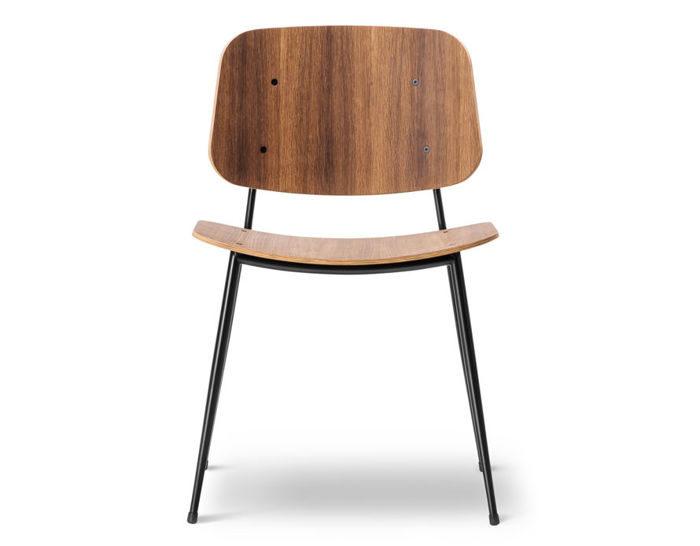soborg steel base chair
by Børge Mogensen from Fredericia - sale
soborg steel base chair
Design Borge Mogensen, 1952
Wood, steel frame
Made in Denmark by Fredericia
An extremely contemporary design, the Soborg chair bridges the contrast between industrial and handcrafted solutions, along with the textural properties of solid wood, plywood and steel. All compounded with a lightweight and solidly grounded aesthetic.
In 1948, Mogensen participated in MoMA's "low-cost furniture" international design competition together with his friend Hans J. Wegner. With homes in Denmark serving as the inspiration for the exhibition, he conducted his first experiments with plywood shells.
Mogensen exhibited the first prototype for the Soborg Chair in 1950. His intention was to make a shell chair that could be produced with new machineries of the time. The rounded shaped seat and back in molded plywood combined with a solid wood frame, reflected how Mogensen fused his international contact with traditional cabinet-makers' solutions and his own functionalist design identity.
In 1952, Mogensen expanded the series with a steel framed chair. Working with steel was exception, rather than rule, in Mogensen's work ethic, but the execution was typical of Mogensen. Adding details such as the slightly tapered legs, Mogensen successfully demonstrated the use of woodworking methodologies in steel, which means the Soborg chair has a visual expression that is less industrial and more crafted.
A true functionalist, Mogensen believed that furniture should encourage freedom of personality. With its discrete design, sturdy construction and generous width, the Soborg Chair expresses this perfectly in any environment...at home, in restaurants, in working areas or any socially engaging space.
The Soborg collection can be specified in all wood, upholstered seat, upholstered seat & back and with either a metal or wood base.
31.3" h | 20.1" w | 19.9" d | seat: 17.9" h | 13.2 lbs.
Wood, steel frame
Made in Denmark by Fredericia
An extremely contemporary design, the Soborg chair bridges the contrast between industrial and handcrafted solutions, along with the textural properties of solid wood, plywood and steel. All compounded with a lightweight and solidly grounded aesthetic.
In 1948, Mogensen participated in MoMA's "low-cost furniture" international design competition together with his friend Hans J. Wegner. With homes in Denmark serving as the inspiration for the exhibition, he conducted his first experiments with plywood shells.
Mogensen exhibited the first prototype for the Soborg Chair in 1950. His intention was to make a shell chair that could be produced with new machineries of the time. The rounded shaped seat and back in molded plywood combined with a solid wood frame, reflected how Mogensen fused his international contact with traditional cabinet-makers' solutions and his own functionalist design identity.
In 1952, Mogensen expanded the series with a steel framed chair. Working with steel was exception, rather than rule, in Mogensen's work ethic, but the execution was typical of Mogensen. Adding details such as the slightly tapered legs, Mogensen successfully demonstrated the use of woodworking methodologies in steel, which means the Soborg chair has a visual expression that is less industrial and more crafted.
A true functionalist, Mogensen believed that furniture should encourage freedom of personality. With its discrete design, sturdy construction and generous width, the Soborg Chair expresses this perfectly in any environment...at home, in restaurants, in working areas or any socially engaging space.
The Soborg collection can be specified in all wood, upholstered seat, upholstered seat & back and with either a metal or wood base.
31.3" h | 20.1" w | 19.9" d | seat: 17.9" h | 13.2 lbs.
Børge Mogensen
Børge Mogensen helped to create the foundation of Danish Modern Design. His life-long ambition was to create durable and useful furniture that would enrich lives.
Fredericia is a Danish Modern design house with a heritage of honoring quality through careful selection of materials, attention to detail and craft.












 write a review now
write a review now
